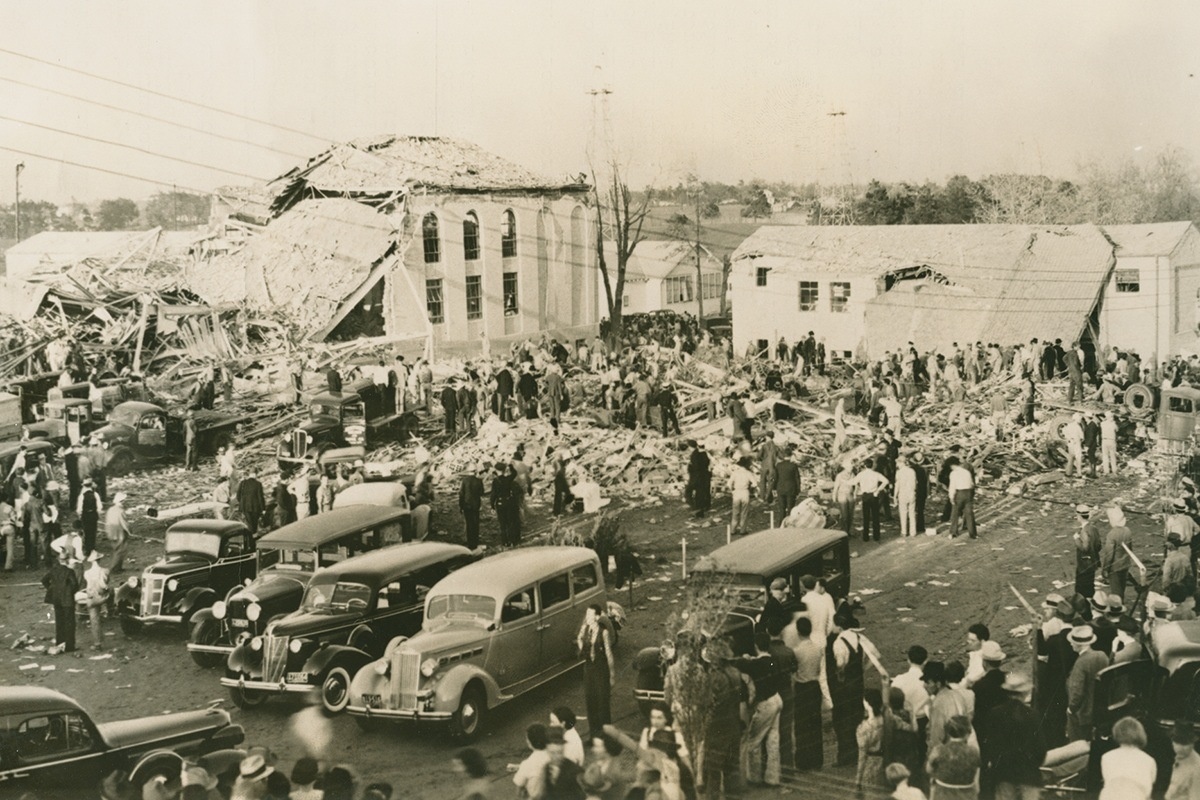During the 1930s, as the gloom of the Great Depression lingered across America, East Texas experienced a financial boom because of the discovery of oil. The newfound resource brought a population surge and unexpected prosperity.
New London became home to one of the richest rural school districts in the nation. A modern facility for grades K–11 (there was no 12th grade) was completed in 1932. The campus encompassed busy oil derricks and pipelines, and included an elementary school, a junior/senior high school, a gymnasium and the first-in-the-area lighted stadium for Friday night football games.
No expense was spared. Yet, to save $300 per month, school officials decided to tap into a residue line of Parade Gasoline Company and obtain free natural gas, then considered a valueless byproduct from the oil wells. The oil companies had no use for the gas, and siphoning some of it from a pipeline for homes and businesses was a common money-saving practice. At that time, natural gas had no distinctive odorized additive.
Unknown to anyone, an estimated 64,000 cubic feet of natural gas leaked from a faulty connection and accumulated in the basement beneath the junior/senior high school building. At 3:17 p.m. on Thursday, March 18, 1937, as high school classes were about to adjourn, the machine shop teacher flipped a switch to turn on a power sander.
The switch ignited the gas, and the building exploded with a force that could be felt for miles. The main school building’s walls and roof collapsed, crushing victims in a massive pile of debris.
Hundreds of people rushed to the scene and began digging through the rubble. Desperate parents struggled to find their children. Rescue workers, including nurses and doctors, law enforcement, oil field roughnecks and Texas Rangers, rushed to the site. Buildings in the area were converted into morgues and field hospitals. Floodlights were set up, and rescuers searched for victims through the night. Seventeen hours after the blast, the site was clear. The grief-stricken community reeled in shock.
Of the 500 students and 40 teachers in the building, approximately 294 died in the explosion, making it the third-deadliest disaster in Texas history. Only the 1900 hurricane in Galveston, in which 6,000–8,000 people perished, and the 1947 Texas City ship explosion, which claimed 576 lives, killed more people.
Every family in New London was affected. Ten days later, when classes resumed in the gymnasium and makeshift tents, only about half of the original students were in attendance. A new building, which would become today’s West Rusk High School, opened its doors two years later. Many New London residents would not recover from the tragedy. Some moved away; some never spoke of it.
The world shared the community’s grief. Hundreds wired their condolences. Funds for a monument were donated, and in 1939, a 32-foot tall granite cenotaph was erected near the site. The names of the victims are engraved around its base.
Parents filed charges of negligence, but all lawsuits were eventually dismissed, and no individual was found to be liable or directly responsible. The Texas Legislature mandated that all utility gas be odorized so that leaks can be more easily detected; other states and countries followed suit. Today, natural gas and propane emit the distinctive rotten-egg odor of the harmless but pungent chemical mercaptan.
The London Museum opened in 1998 across from the explosion site on Texas Highway 42. Visitors can view a collection of photographs and newspaper clippings, telegrams and letters of condolence, transcripts of survivor accounts and personal artifacts gathered from the wreckage.
The museum also offers a working 1938 soda fountain and small café. Volunteers, including head docent John Davidson, whose older sister died in the explosion, are dedicated to promoting awareness of the tragedy and keeping alive the memories of those who died that day.
“There is an old saying,” says Davidson, “ ‘No one is ever dead, truly dead, until no one remembers them and no one speaks their name.’ We remember.”
——————–
Cyndy Irvine is a San Antonio native.


